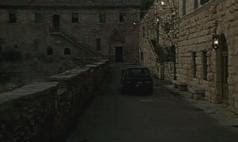Andrei Tarkovsky uses a very new cinematic language to present the in depth levels of feeling reveal from his movie Nostalgia. The images that he uses- water, fire, candle, dog, ruin building…etc shows material imagination.
Water, fire and candle
Water, fire and candle are very symbolic elements in the film. Bachelard states” One cannot dream profoundly with objects. To dream profoundly, one must dream with substances.” The mixture of the substances- water and fire strongly hint the psychological logic of Domenico’s violent end where as candle shows the association of flame and life, the personal memories that are from Tarkosvsky.
Dog
Tarkovsky uses a wolfhound rather than a dog to show the contradictory images of safety and threat, fidelity and savageness. Once again, in the scene of ruin Italian cathedral and the Russian house, shows a strike of too literal and fabricated.
Ruin building
Ruin has played a very essential role of a building; it recalls the history from the past and eventually moves on with a new structure. However, the leaking and flooded building implies the tragic sentiments hidden behind the utilitarian face of architecture.
Tarkovsky also considers on the basis of architecture- space, lighting and sounds.
Space
The style of Tarkovsky creates the space of the scene are very slow and prolonged. Each scene is like a piece of painting. It is just like you enter into a gallery, standing in front of a painting; interpret it for more than 10 minutes. There are several scenes that Tarkovsky achieves to go beyond the space from the screen. Here are the examples:
 1. Opening scene. Car drives across foggy landscape to the left frame, then return left.
1. Opening scene. Car drives across foggy landscape to the left frame, then return left.
The style of Tarkovsky creates the space of the scene are very slow and prolonged. Each scene is like a piece of painting. It is just like you enter into a gallery, standing in front of a painting; interpret it for more than 10 minutes. There are several scenes that Tarkovsky achieves to go beyond the space from the screen. Here are the examples:
 1. Opening scene. Car drives across foggy landscape to the left frame, then return left.
1. Opening scene. Car drives across foggy landscape to the left frame, then return left.2. St. Catherine’s pool. Camera uses parallel techniques to
film the pool shows the black bar to tell the existence of arcade.
film the pool shows the black bar to tell the existence of arcade.
camera moves parallel to the pool in front.
lighting
Lighting is a very essential element to create space. Tarkovsky uses windows and doorways to create looking out or into for space. In the scene where Gochakov enters his room, shows the use of abstract counterpoint of spaces (which means juxtaposition/contrast), alternating in darkness and light.
Lighting is a very essential element to create space. Tarkovsky uses windows and doorways to create looking out or into for space. In the scene where Gochakov enters his room, shows the use of abstract counterpoint of spaces (which means juxtaposition/contrast), alternating in darkness and light.
1. When Gorchakov enters the room, light seeps into darkness through shutter.
3. Closed shutters and switch on lamp. Turn off blinking light
bulb. Turn on lamp.
4. Reflection of blue natural light from bathroom.
bright white light.
Sound
Tarkovsky uses natural sounds to activate the viewer’s sense of space and scale. He shapes the space with music beyond the screen. He always has a reason for the sound.
Tarkovsky uses natural sounds to activate the viewer’s sense of space and scale. He shapes the space with music beyond the screen. He always has a reason for the sound.
horror when Domenico is on fire.
2. Domenico’s house. The rain drops create the sense the dense volume.
3. The dog moves the bottle. It takes nearly one minute to
show the movement of the bottle rolling on the floor. The sound suggests the size of the space in the room.
I download this movie without subtitle; therefore my understandings of the film are most likely relying on the notes and from the visual images. However, the beneficial is that I can focus more on the film techniques Tarkovsky uses, which I can empathy the feeling in a more in depth level rather than from texts. Tarkovsky states “There is only one way of cinematic thinking- poetic”. “When I speak of poetry I am not thinking of it as a genre. Poetry is an awareness of the world, a particular way of relating to reality. “” Poetry is untranslatable, as all art.” Overall, I really like this film. I like the way how a film can present in a very fine art form, at the same time the film considers the basis of architecture.










No comments:
Post a Comment